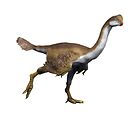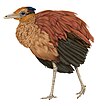鱼鸟属
外观
(重定向自鱼鸟)
| 鱼鸟属 | |
|---|---|

| |
| 异椎鱼鸟(I. dispar)的复原图 | |
| 科学分类 | |
| 界: | 动物界 Animalia |
| 门: | 脊索动物门 Chordata |
| 纲: | 蜥形纲 Sauropsida |
| 总目: | 恐龙总目 Dinosauria |
| 目: | 蜥臀目 Saurischia |
| 亚目: | 兽脚亚目 Theropoda |
| 演化支: | 鸟翼类 Avialae |
| 演化支: | 今鸟型类 Ornithuromorpha |
| 演化支: | 扇尾类 Ornithurae |
| 演化支: | †鱼鸟类 Ichthyornithes |
| 属: | †鱼鸟属 Ichthyornis Marsh, 1873 |
| 模式种 | |
| †异椎鱼鸟 Ichthyornis dispar (Marsh, 1872)
| |
| 异名 | |
|
Angelinornis Kashin 1972 种异名
| |
鱼鸟属(学名:Ichthyornis)是一属已经灭绝的鸟类,其下仅有模式种异椎鱼鸟(学名:Ichthyornis dispar)一个有效种。鱼鸟生存在白垩纪晚期(约在 95–83.5 百万年前)的北美洲,牠们的化石可以在加拿大亚伯达省、萨克其万、美国阿拉巴马州、堪萨斯州、新墨西哥州与德州的白垩岩中发现,位置皆为当时属于西部内陆海道的区域。
鱼鸟在鸟类演化史上扮演着很重要的角色,为最早发现仍然保有牙齿特征的化石鸟类,而这项特征也间接佐证了查尔斯·达尔文的演化论。鱼鸟同时也是少数保有化石样本的中生代扇尾类。
描述
[编辑]

鱼鸟的生活形式与现存的海鸥、贼鸥、剪嘴鸥等海鸟类似,有着相同的生态区位。鱼鸟的平均体型与鸽子接近,平均体长约为24厘米(9.4英寸),平均翼展则为43厘米(17英寸)(不含羽毛)[2],不过在不同标本之间鱼鸟的体型差异非常大,如标本YPM 1742的翼展就长达73厘米(29英寸),远高于平均翼展。[1]
鱼鸟的脊椎骨为双凹型关节面,与鱼类的脊椎骨类似,因此得名。鱼鸟的上、下颌中段具有槽生齿,前端则为喙。喙与黄昏鸟类似,由数枚角质片组成,如同现今的信天翁。[3]牙齿后勾不带有锯齿边缘,比起鳄鱼与某些兽脚亚目恐龙的牙齿更为类似。[1]
虽然带有牙齿,不过鱼鸟的翅膀与胸骨发展得十分完善,胸骨龙骨突发达,与现今的鸟类类似,可能同样拥有不错的飞行能力。和较早期的反鸟亚纲成员不同,鱼鸟自出生后就会以极快且稳定的速度达到成熟。[4]
大众文化
[编辑]- 鱼鸟出现在2000年华特迪士尼动画工作室及秘密实验室出品的电脑动画电影《恐龙》中。
- 鱼鸟也出现在Discovery的《恐龙行星》(Dinosaur Planet )的第2集中。
- 在沙盒动作冒险游戏《方舟:生存进化》中,玩家可以捕捉并驯服鱼鸟, 不过该鱼鸟会臭名昭彰的窃取玩家的食物而被认为是最令人厌恶的生物之一。
外部链接
[编辑]- Ichthyornis dispar: A toothed, flying bird from the Late Cretaceous of Kansas(页面存档备份,存于互联网档案馆) by Mike Everhart, Oceans of Kansas website. Retrieved 2006-09-16.
参考文献
[编辑]- ^ 1.0 1.1 1.2 Clarke, J.A. Morphology, phylogenetic taxonomy, and systematics of Ichthyornis and Apatornis (Avialae: Ornithurae) (PDF). Bulletin of the American Museum of Natural History. 2004, 286: 1–179 [2018-06-17]. doi:10.1206/0003-0090(2004)286<0001:MPTASO>2.0.CO;2. (原始内容 (PDF)存档于2009-03-03).
- ^ Shimada, K.; Fernandes, M.V. Ichthyornis sp. (Aves: Ichthyornithiformes) from the lower Turonian (Upper Cretaceous) of western Kansas. Transactions of the Kansas Academy of Science. 2006, 109 (1/2): 21–26. doi:10.1660/0022-8443(2006)109[21:ISAIFT]2.0.CO;2.
- ^ Lamb, J.P. Jr. Marsh was right: Ichthyornis had a beak. Journal of Vertebrate Paleontology. 1997, 17: 59A. doi:10.1080/02724634.1997.10011028.
- ^ Chinsamy, A., Martin, L.D. and Dobson, P. Bone microstructure of the diving Hesperornis and the volant Ichthyornis from the Niobrara Chalk of western Kansas. Cretaceous Research. April 1998, 19 (2): 225–235. doi:10.1006/cres.1997.0102.























